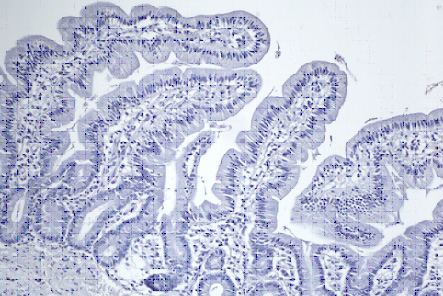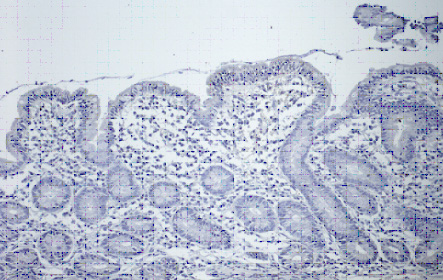|
1. Aquaporins and solute transporters expression in coeliac disease
Coeliac disease (CD) is an autoimmune enteropathy characterized by villous atrophy, crypt hyperplasia and heavy inflammatory infiltrate of both epithelium and lamina propria due to a T-cell response to an array of epitopes of dietary gliadin in genetically susceptible individuals (Fig. 1 and 2). Malabsorption syndrome is one of the most frequent clinical picture at diagnosis.
The purpose of this research project is to study the possible changes in expression and the tissue localization of water and solute channels and transporters in celiac disease patients. The characterization of these transport pathways in celiac disease, little investigated until now, could be crucial in assessing the reasons of the severe clinical symptoms that developed in progress of the disease.
 
Fig. 1. Normal jejunal mucosa. Fig. 2. Jejunal mucosa in celiac disease
2. Aquaglyceroporins expression and function in human white adipose tissue
The physiology of adipose tissue has a key role in the pathogenesis of the metabolic syndrome and related cardiovascular disorders. Some of the adipocytes functions are energy storage and release on demand. Kuriyama et al. (Biochem Biophys Res Commun. 1997, 241(1):53-8) cloned and identified a specific glycerol channel from human adipose tissue that belongs to the aquaporin family, successively named aquaporin 7. Recently, the importance of aquaporin 7 and, generally, of the glycerol transport mechanisms in the adipose tissue has been remarked by several leading authors, especially, in relation to the development of the obesity observed in aquaporin 7 null mice.
Since, until now, the correlation AQP7-obesity has not been demonstrated in humans, the presence of another mechanism (transporter or aquaporin) for glycerol transport in human adipocyte cannot be ruled out. The discovery of this mechanism is of fundamental importance for the development of specific therapies for the cure of the human obesity, a physiopathologic condition that afflicts a large number of people in the western countries. The research project is addressed to identify and functionally characterize other possible aquaglyceroporins or glycerol transport mechanisms in human white adipose tissue.
Fig. 3. Aquaporin 7 localization in human subcutaneous adipose tissue.
3. Molecular mechanisms involved in the differentiation of CD133+ into endothelial cells or cardiomyocytes: role of the Ca2+ signalling
Cell therapy based on inoculation of human stem cells has provided a novel therapeutic approach for the treatment of cardiovascular diseases. However, cell therapy has still a poor outcome and obtaining the required large number of precursor cells is still difficult. It has been demonstrated that CD133+ cells may be differentiated, in vitro, either in endothelial or in cardiomyocyte precursors depending on the culture medium.
Highlighting the cellular events controlling the differentiation process of CD133+ will likely: 1) allow to obtain a larger number of precursor cells from the few isolated cells, 2) improve prediction of the behaviour of injected stem cells within damaged vessels or ischaemic tissue and 3) suggest novel strategies in order to improve their differentiation outcome. To this end, the investigation will focus on the role of Ca2+ signalling in driving stem cells differentiation towards an endothelial or a myocardial phenotype: this might open new perspective for cell replacement therapy.
4. Characterization of neuronal ELAV proteins in memory and their alterations in brain aging and in neurodegenerative disorders
Neuronal ELAV (nELAV) proteins are RNA-binding proteins that can control the post-transcriptional fate of specific bound mRNAs, from alternative splicing and nucleocytoplasmic shuttling to their stability and translation. They enhance gene expression by increasing mRNA half-life and/or by promoting protein synthesis through a still unknown molecular mechanism.
Gain knowledge on nELAV functioning can open new perspectives on potential tools useful to counteract some aspects associated to brain aging and neurodegeneration.
5. Aquaporins expression and function in rat gastrointestinal tract
Water transport through the mammalian small intestine is physiologically crucial for maintaining the water body homeostasis. About 90% of water introduced with the diet and derived from the digestive juices secretion is absorbed by the small intestine. Some aquaporins, the water-specific channels, were found in the small intestine epithelium.
The aim of this study was to further characterize the cellular localization of aquaporin 6, 7, 8, 10 and to clarify their functional role in water transport through the small intestine.
Fig. 4. Osmotic water permeability of brush border membrane vesicles from rat small intestine. Representative light scattering curves obtained by exposing untreated vesicles (Control) and vesicles treated with HgCl2. vesicles to a osmotic gradient.
|



